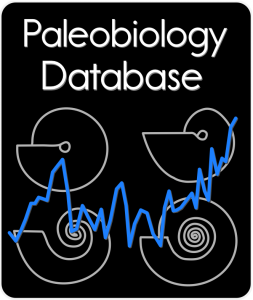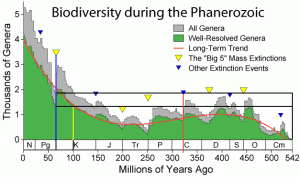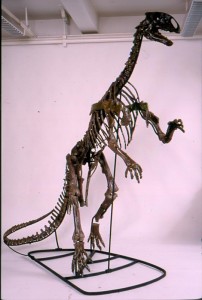Most of what we know about dinosaurs comes from their skeletal remains. Rarely, we get tiny glimpses into their soft tissue anatomy through skin impressions and even rarer, preserved tissue fragments, mummified over time, and their ecology and life habits through combining interpretation of this from what we can glean from trace fossils (footprints, poop, etc.). Palaeontologists are also taking the first steps to digitally reconstructing their muscular systems through looking at muscle attachment points on bones and comparing this with their living archosaur relatives, crocodiles and birds. But what if we could actually peer inside their skulls to look at their brains? Brains, unsurprisingly, are not preserved in the fossil record. This is due to two, equally scientifically valid points – brains are nutritious, and when a dinosaur dies, their brains are usually scavenged by other carnivores so that they can assimilate the brain-host’s knowledge (and their hearts, for courage)*, and secondly, soft tissue does not readily preserve under normal taphonomic conditions, and only exceptionally rarely under the right conditions, which are typically deep marine anoxic environments (not something any known dinosaur is yet known to have inhabited).
Who the devil are this ‘public’ everyone keeps rambling on about?
The last two posts in this series, based on a recent paper by Ted Nield and Iain Stewart, addressed the issues of why should scientists bother communicating, and what do people in general already know about science, and geoscience in particular. Oddly, these are the most fundamental questions when it comes to science communication, but often can be the most difficult to answer. They either require a degree of personal subjectivity, or data that can be extremely difficult to obtain and measure in any meaningful way.
Throughout any discussion of science communication, the ‘engagees’ are typically referred to as ‘the general public’, and on a more specific level, public stakeholders – those who require or will use in some way the information being conveyed to them. Scientists are probably best at communicating between other branches of scientist, be they in academia, industry, government, or elsewhere. I guess this is due to the inherent fact that there will more often be a commonality of both understanding and interest, within fields, that may not be as highly replicated outside of these spheres.
The Palaeobiology Database – a quick intro
A substantial portion of my PhD involves contributing to the Pal[a]eobiology database, the largest current online database of global fossil occurrences, literature references, and taxonomic data. It’s a public resource, so anyone can access the information contained within the database (yay for open data!). The project is very much on-going, but currently over a million taxonomic occurrences have been input, from a range of international contributors (usually post-docs, research fellows and their minions, aka PhD students). Ultimately, the aim is to provide global, collection-based occurrence and taxonomic data for all groups of any geological age. Along with this, there is a selection of web-based software that anyone can use for the simple statistical analysis of whichever portion of the data they chose to access. According to the website, the long-term goal is also to encourage collaboration across the globe so that palaeontologists can help answer some of the large-scale questions that exist in terms of the evolutionary history of life on Earth. That’s a pretty decent thing to aim for.
Unfortunately, but also thankfully, only ‘professional researchers’ can actually input data. This is to impose a degree of rigour, as if any old Tom Dick or Harry could enter or modify data, there would be serious data validity issues. You can see what the various groups of researchers are working on here, and it’s pretty varied! Anything from calculating clade occurrence times and comparing/combining this with molecular data, to diversity trends of plants through the last few hundred million years.
Where I think the real strength of the database lies, is that it can be analysed in congruence with other datasets, such as various climatic variables, land area, and latitude, to see how individual lineages and groups have co-evolved with the planet and Earth systems through time, and use this as a predictor of future trends in biodiversity; something that is especially important given that we may be heading into a time of exceptional pressure on biological systems.
What I’m gonna be doing with the database in particular, is filling out the entire Upper Jurassic tetrapod occurrence bit, and combining this with the Early Cretaceous dataset, which is nearing completion thanks to a mammoth effort from many people, including my supervisor Phil Mannion, to look at extinction dynamics and selectivity patterns in terrestrial tetrapods throughout this period. More on this, when I actually have the data! Many exceptional publications have already come out of this project, the latest just a couple of days ago looking at the Cretaceous tetrapod record, which I’ll be writing about shortly on here.
SpotOn London – a global conference
SpotOn London was held this weekend at the Wellcome Trust, shockingly, in London. The name stands for Science Policy, Outreach and Tools Online, with each of these representing three individual but strongly interwoven strands during the two days. As far as conferences go, it was pretty interactive. Each session was live-streamed, and through that and the power of Twitter –many people in each session either had an ipad, laptop, or mobile phone out tracking the online conversation, and drawing in additional comments from those who couldn’t be there in person.
It was also nice to briefly meet Barbara and Edvard of the EGU network (*waves at*). Apart from the small geo-cadre, the rest of the delegates represented in total the entire scientific discipline, from PhD students to BBC science reporters, communications managers, and those who work in science policy. When you consider science as being an interactive process, pretty much everyone present can be classed as some brand of scientist, representing the huge social range of the field. That’s intended as a compliment to any attendees who read this!
So, why as a PhD student and palaeontologist, did I go to this conference? The primary reason is that I was actually invited to co-co-ordinate a session with Michelle Brook, the Head of Policy at the Physiological Society. As well as this, the ‘science communication network’, consisting rather loosely of those who do various outreach initiatives, work in science policy, reporting, editing, publishing, are an insanely valuable resource for personal development as an early career scientist. I only ‘joined’, or became aware of, this community around a year ago, and since then have begun to learn about issues such as gender bias in science, the open access movement, the role of science in government, the role of learned societies, as well as the value of blogging, and various other forms of communication, among other things. This has largely been fueled by being pretty active on Twitter, which is a pretty awesome way of staying in touch with the world beyond the desk/lab, and made a whole lot easier by living in London, which is undoubtedly the UK’s hub of science communication-relevant events, people, and organisations (ranging from CaSE to BioMed Central’s publishing house, and everything in between).
So yeah, the session. We decided to strike for the pretty hot topic of increasing engagement between scientists and policymakers. The panel consisted of Nic Bilham, Head of External Relations and Strategy at the Geological Society (and my old boss, who taught me everything I know about geoscience policy), Julian Huppert, the MP for Cambridge, and strong supporter of science within government, and Anna Zecharia, a post-doc at Imperial College, Head of the Science Communication Forum there, and someone with pretty big ideas for science communication and policy in the future. Michelle chaired the session. You can see their discussion here:
As well as this, we also organised a workshop to follow on from this discussion. If you want to see what any of this was like on Twitter, check out the #solo12sp hash tag. The video feed for this session was a bit fuzzy, seeing as how we had several discussions happening at the same time, based on the format idea of a ‘marketplace of discussion’, with the three panelists fueling debate and conversation by acting as focal areas of expertise. The idea is to take the notes and ideas made during this session, and collate them into some sort of guide document that scientists and policymakers can use to increase reciprocal engagement between the two. That’s not to say the two ‘sides’ are mutually distinct, and that interaction doesn’t happen already. It’s just that there could be more of it, and if some sort of strategic framework were established whereby communications between the two fields increased, for the benefit of both, then it would be mutually beneficial in terms of having more evidence-informed policies, where needed, and more policy-aware scientists. As far as how geology/geoscience fits in to this, I think, and I’m sure many would agree, that in times of issues such as climate change, energy security, natural hazards, radioactive waste, the more geoscientific input we have, the more informed we can be when it comes to tackling these. Where does palaeontology come in to all this? I’ll let you know when I’ve figured that one out.




